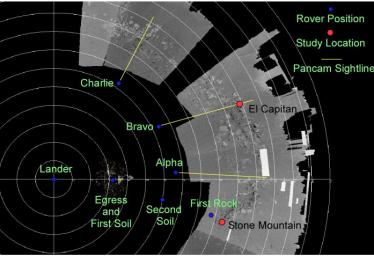This Long Term Planning graphic was created from a mosaic of navigation camera images overlain by a polar coordinate grid with the center point as Opportunity's original landing site. The blue dots represent the rover position at various locations.The red dots represent the center points of the target areas for the instruments on the rover mast (the panoramic camera and miniature thermal emission spectrometer). Opportunity visited Stone Mountain on Feb. 5. Stone Mountain was named after the southernmost point of the Appalachian Mountains outside of Atlanta, Ga. On Earth, Stone Mountain is the last big mountain before the Piedmont flatlands, and on Mars, Stone Mountain is at one end of Opportunity Ledge. El Capitan is a target of interest on Mars named after the second highest peak in Texas in Guadaloupe National Park, which is one of the most visited outcrops in the United States by geologists. It has been a training ground for students and professional geologists to understand what the layering means in relation to the formation of Earth, and scientists will study this prominent point of Opportunity Ledge to understand what the layering means on Mars.
The yellow lines show the midpoint where the panoramic camera has swept and will sweep a 120-degree area from the three waypoints on the tour of the outcrop. Imagine a fan-shaped wedge from left to right of the yellow line.
The white contour lines are one meter apart, and each drive has been roughly about 2-3 meters in length over the last few sols. The large white blocks are dropouts in the navigation camera data.
Opportunity is driving along and taking a photographic panorama of the entire outcrop. Scientists will stitch together these images and use the new mosaic as a "base map" to decide on geology targets of interest for a more detailed study of the outcrop using the instruments on the robotic arm. Once scientists choose their targets of interest, they plan to study the outcrop for roughly five to fifteen sols. This will include El Capitan and probably one to two other areas.
Blue Dot Dates
Sol 7 / Jan 31 = Egress & first soil data collected by instruments on the arm
Sol 9 / Feb 2 = Second Soil Target
Sol 12 / Feb 5 = First Rock Target
Sol 16 / Feb 9 = Alpha Waypoint
Sol 17 / Feb 10 = Bravo Waypoint
Sol 19 or 20 / Feb 12 or 13 = Charlie Waypoint

 Planetary Data System
Planetary Data System












